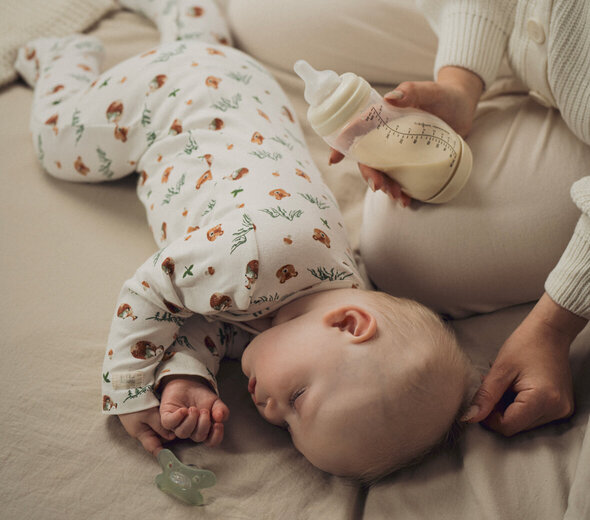

There are two types of teats on the market: made of silicone or latex. Feeding bottles with silicone teats are definitely more popular, but they are not suitable for all babies. If your baby doesn't want to suck from the bottle with a silicone teat, try using a latex teat instead. When combining breastfeeding and bottle feeding, use a silicone teat - it reduces the risk of rejecting breast by the baby. Latex teats are brown in colour and have a light smell of rubber. Their advantage is that they are durable and resistant to biting. On the other hand, they darken under the influence of sunlight - therefore, they need to be changed regularly, preferably once every few weeks. Silicone teats are transparent, odourless and tasteless. They are less bite-resistant than rubber teats, but they are more resistant to sunlight. They don't change the taste of food.
Remember that different bottle producers make different bottle shapes. Therefore, a teat from one producer may not fit the bottle of another. Also, a teat designed for wide-necked bottles won't fit a narrow-necked bottle. Teats come in three different shapes: anatomical (orthodontic), universal (rounded) that is elongated, and a wide, natural-shaped teat, e.g. the Balloon, which resembles mum's nipple. The latter is especially recommended for babies who are fed using both breastfeeding and bottle feeding.
You can find silicone and rubber teats in six various teat flow rates, marked on the packages with a number from 0 to 5. Frame with teat flow rates, similar to the one in the Young Mum's ABC, or the following description: 0 newborn - teat with the slowest flow rate; suitable for drinking baby juice or tea, for children under 6 months. 1 slow - suitable for first milk; for children under 6 months. Can also be used for tea and baby juice for children over 6 months. 2 medium - suitable for milk; for children between 6 and 12 months. Can also be used for tea for children over 12 months. Remember, that children at this age can already start drinking juice and tea from a cup with special spout. 3 fast - teat suitable for children over 12 months, who still like to drink milk from the bottle. Remember, that this teat is not recommended for food of thicker consistency, as the hole is too small. cross-cut - a teat that is ideal for foods of thicker consistency, such as soups or baby cereal with milk. 5 variable - teat for children over 3 months. By setting the teat with a certain sign pointing towards your baby's nose, you will get the proper flow rate: slow, medium or fast. When to substitute teat with spout? If you want your baby to learn to drink from a cup with spout, put the spout marked with a 6 on the bottle, instead of a teat. It's less profiled than the teat. You can start using it when your baby is 6 months old. You can choose from soft silicone spouts, suitable for children over 6 months old, and firm spouts for children over 12 months old. On the picture, the more narrow spouts fit the standard bottles, whereas the wider spouts fit the Balloon bottles. (Pictures of spouts, similar to the ones in the Young Mum's ABC).